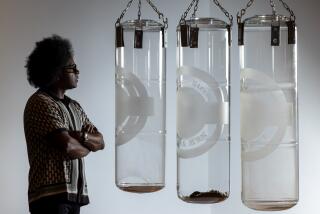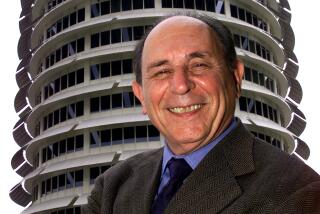Review: A new R. Buckminster Fuller exhibition goes far beyond the dome
If you’re already familiar with R. Buckminster Fuller, you won’t learn much from the current exhibition at Edward Cella Art & Architecture. It’s not much of an introduction, either, but still presents an opportunity to reflect on the legacy of this visionary thinker.
Fuller, who died in 1983, spanned the disciplines of architecture, design and engineering. He is best known for the geodesic dome, a rounded form composed of interlocking triangles that was later found to be the same structure underlying protein molecules. He is so revered in art, design and inventor circles that most of the artifacts associated with his practice are ensconced in museums and his archives at Stanford University. This exhibition is a selection of rare objects still on the market, so it’s a bit spotty.
The show is dominated by a portfolio of prints Fuller created shortly before his death. These images reproduce technical drawings from his patent applications for things like the Dymaxion house and car. (“Dymaxion” is his invented word for maximum performance with the least effort.) Screenprinted in white on clear mylar, each of these is paired with a backing sheet of blue paper and a black-and-white photographic image of the resulting structure or product. The prints can be displayed as “blueprints” on the blue backing or as overlays on top of the photographic images.
This latter combination is displayed in the gallery. Although appealing, complex images in their own right, the layered prints are hard to decipher and don’t actually convey much about Fuller’s innovative designs. They feel like an artist looking back rather than caught in the throes of a good idea.
More satisfying are a selection of small steel and wire spheres made to illustrate design principles: straight elements held in tension to form dynamic, rounded volumes. Also neat to see is an actual product, “Dymaxion Rowing Shell,” a bright red and blue boat that looks like a water bug splayed on a set of skis. It exemplifies Fuller’s drive to improve on traditional designs using principles derived from nature.
Fuller’s holistic approach — he saw all of us as fellow astronauts on “Spaceship Earth” — is even more relevant in our days of global warming. The show includes the film “Bucky and Spaceship Earth,” a great 20-minute synopsis of his global vision.
His “Dymaxion Air-Ocean World Map,” from 1980, depicts the globe splayed across a network of triangles. The land masses and oceans are color-coded according to their mean low temperatures, numbers that would certainly be higher today. The triangles were Fuller’s attempt to create a more accurate map of Earth. He believed it was impossible to make good decisions without good information — a sentiment sadly still ahead of its time.
Edward Cella Art & Architecture, 2754 S. La Cienega Blvd., (323) 525-0053, through Nov. 3. Closed Sunday and Monday. www.edwardcella.com
More to Read
The biggest entertainment stories
Get our big stories about Hollywood, film, television, music, arts, culture and more right in your inbox as soon as they publish.
You may occasionally receive promotional content from the Los Angeles Times.










